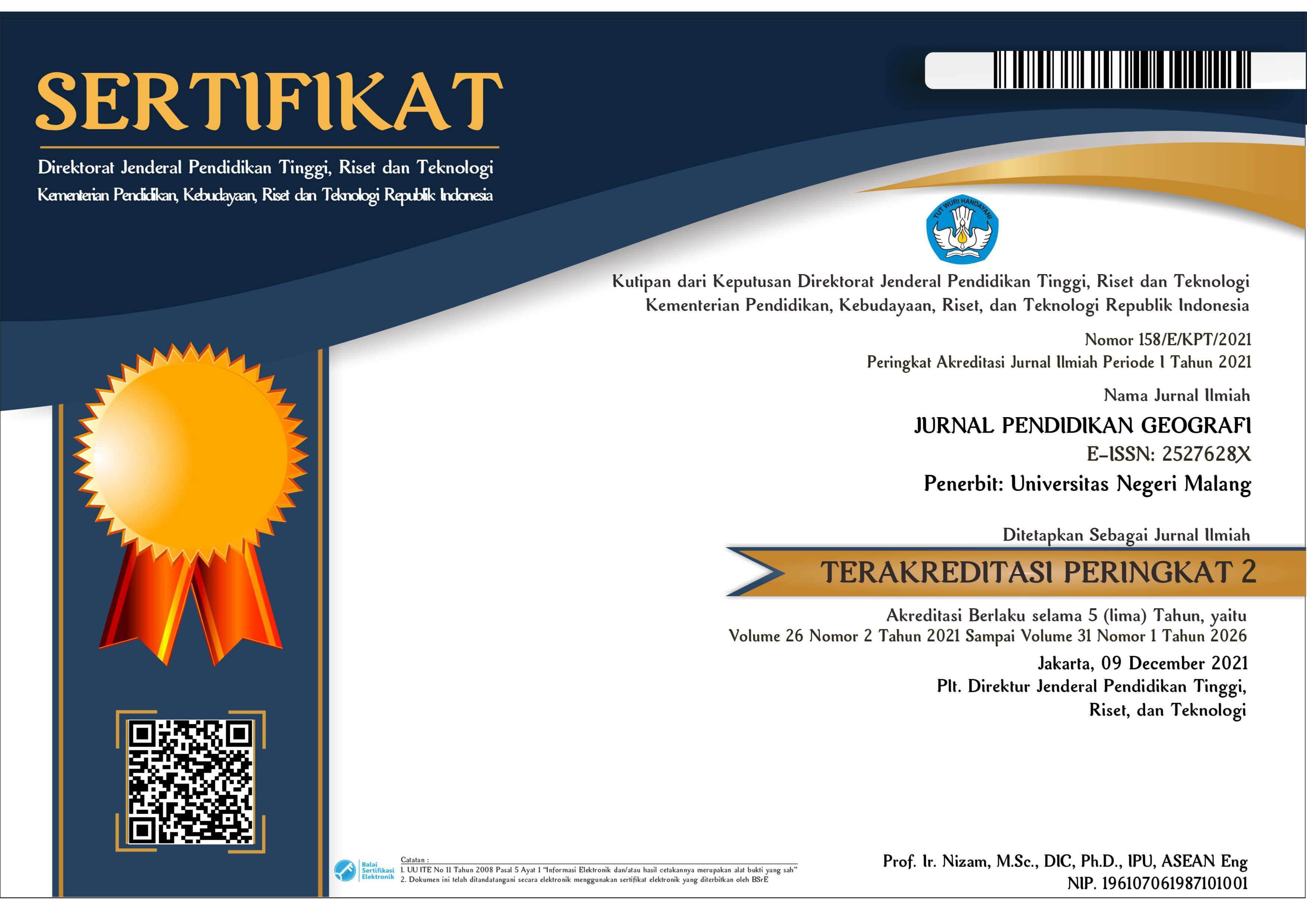Analysis on the change of runoff curve number influence to surface flow debit using ALOS AVNIR-2 data imagery
Abstract
Keywords
Full Text:
PDFReferences
Ahmad, I., & Verma, M. K. (2018). Application of analytic hierarchy process in water resources planning: A GIS based approach in the identification of suitable site for water storage. Water Resources Management, 32(15), 5093–5114. https://doi.org/10.1007/S11269-018-2135-X
Anurogo, W., Lubis, M. Z., Pamungkas, D. S., Hartono, H., & Ibrahim, F. M. (2017). A spatial approach to identify slum areas in East Wara Sub-Districts, South Sulawesi. IOP Conference Series: Earth and Environmental Science, 98(1), 1–13. https://doi.org/10.1088/1755-1315/98/1/012030
Anurogo, W,. Lubis, M. Z., & Mufida, M. K. (2018). Modified soil-adjusted vegetation index in multispectral remote sensing data for estimating tree canopy cover density at rubber plantation. Journal of Geoscience, Engineering, Environment, and Technology, 3(1), 15. https://doi.org/10.24273/-JGEET.2018.3.01.1003
Anurogo, W., Murti, S. H., & Khakhim, N. (2015). Analisis perubahan hutan mangrove dalam penentuan kawasan rehabilitasi dan perubahan stok karbon menggunakan data Penginderaan Jauh (di Teluk Banten, Serang Provinsi Banten). Universitas Gadjah Mada.
Danoedoro, P. (2012). Pengantar Penginderaan Jauh. Penerbit Andi.
Ebrahimian, A., Gulliver, J. S., & Wilson, B. N. (2018). Estimating effective impervious area in urban watersheds using land cover, soil character and asymptotic curve number. Hydrological Sciences Journal, 63(4), 513–526. https://doi.org/10.1080/02626667.2018.1440562
Guswa, A. J., Hamel, P., & Meyer, K. (2017). Curve number approach to estimate monthly and annual direct runoff. Journal of Hydrologic Engineering, 23(2), 04017060. https://doi.org/10.1061/(ASCE)HE.1943-5584.0001606
Lal, M., Mishra, S. K., Pandey, A., Pandey, R. P., Meena, P. K., Chaudhary, A., Jha, R. K., Shreevastava, A. K., & Kumar, Y. (2016). Evaluation of the soil conservation service curve number methodology using data from agricultural plots. Hydrogeology Journal, 25(1), 151–167. https://doi.org/10.1007/S10040-016-1460-5
Lian, H., Yen, H., Huang, J. C., Feng, Q., Qin, L., Bashir, M. A., Wu, S., Zhu, A. X., Luo, J., Di, H., Lei, Q., & Liu, H. (2020). CN-China: Revised runoff curve number by using rainfall-runoff events data in China. Water Research, 177, 115767. https://doi.org/10.1016/J.WATRES.2020.115767
Lubis, M. Z., Anurogo, W., Hanafi, A., Kausarian, H., Taki, H. M., & Antoni, S. (2018). Distribution of benthic habitat using Landsat-7 Imagery in shallow waters of Sekupang, Batam Island, Indonesia. Biodiversitas Journal of Biological Diversity, 19(3), 1117–1122. https://doi.org/10.13057/BIODIV/D190346
Sari, R., Anurogo, W., & Lubis, M. Z. (2018). Pemetaan sebaran suhu penggunaan lahan menggunakan Citra Landsat 8 di Pulau Batam. Jurnal Integrasi, 32(1), 2548–9828.
Satheeshkumar, S., Venkateswaran, S., & Kannan, R. (2017). Rainfall-runoff estimation using SCS-CN and GIS approach in the Pappiredipatti watershed of the Vaniyar sub basin, South India. Modeling Earth Systems and Environment, 3, 24. https://doi.org/10.1007/s40808-017-0301-4
Savvidou, E., Efstratiadis, A., Koussis, A. D., Koukouvinos, A., & Skarlatos, D. (2018). The curve number concept as a driver for delineating hydrological response units. Water, 10(2), 194. https://doi.org/10.3390/¬W10020194
Singhai, A., Das, S., Kadam, A. K., Shukla, J. P., Bundela, D. S., & Kalashetty, M. (2019). GIS-based multi-criteria approach for identification of rainwater harvesting zones in upper Betwa sub-basin of Madhya Pradesh, India. Environment, Development and Sustainability, 21(2), 777–797. https://doi.org/10.1007/S10668-017-0060-4/TABLES/11
Sudira, P., Purwadi, T., Sukresno, S., & Nurlaili, M. (2017). Prediksi aliran permukaan menggunakan modifikasi model bilangan kurva. Agritech, 25(1), 10–14. https://doi.org/10.22146/AGRITECH.13372
Tiwari, K., Goyal, R., & Sarkar, A. (2018). GIS-based methodology for identification of suitable locations for rainwater harvesting structures. Water Resources Management, 32(5), 1811–1825. https://doi.org/¬10.1007/¬S11269-018-1905-9
Uwizeyimana, D., Mureithi, S. M., Mvuyekure, S. M., Karuku, G., & Kironchi, G. (2019). Modelling surface runoff using the soil conservation service-curve number method in a drought prone agro-ecological zone in Rwanda. International Soil and Water Conservation Research, 7(1), 9–17. https://doi.org/10.1016/¬J.ISWCR.2018.12.001
Zeng, Z., Tang, G., Hong, Y., Zeng, C., & Yang, Y. (2017). Development of an NRCS curve number global dataset using the latest geospatial remote sensing data for worldwide hydrologic applications. Remote Sensing Letters, 8(6), 528–536. https://doi.org/10.1080/2150704X.2017.1297544
DOI: http://dx.doi.org/10.17977/um017v27i12022p15-25
Refbacks
- There are currently no refbacks.
Copyright (c) 2022 Jurnal Pendidikan Geografi: Kajian, Teori, dan Praktek dalam Bidang Pendidikan dan Ilmu Geografi

This work is licensed under a Creative Commons Attribution-ShareAlike 4.0 International License.
Jurnal Pendidikan Geografi: Kajian, Teori, dan Praktek dalam Bidang Pendidikan dan Ilmu Geografi is licensed under Creative Commons Attribution-ShareAlike 4.0 International License,
JPG Indexed By:
View My Stats









12.png)
